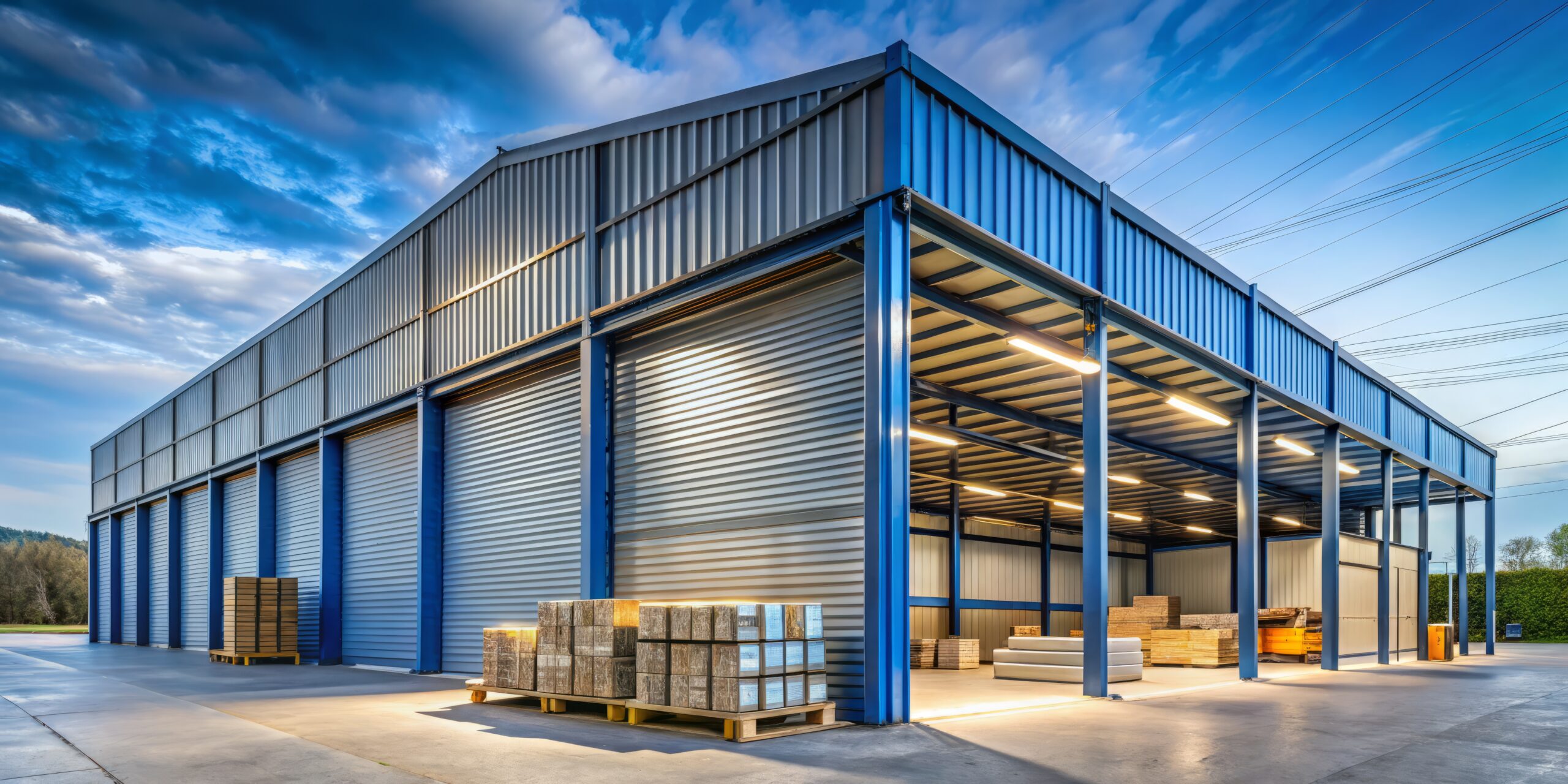Did you know? The global market for pre-engineered metal buildings (PEMBs) is on track to soar to an astonishing $23.5 billion by 2027. This surge is particularly prominent in the commercial and industrial sectors, where the advantages of PEMBs are hard to ignore. With the ability to cut construction time by 50% and reduce costs by 30% compared to traditional building methods, no wonder businesses are making the switch.
In this article, we’ll break down the pros and cons of prefab metal buildings, equipping you with the insights you need to make an informed decision for your next project. Whether you’re looking for speed, savings, or strength, PEMBs might just be the solution you’ve been searching for.
Table of Contents
Understanding Pre-engineered Metal Buildings
Definition and Basic Concept
Pre-engineered metal buildings are structures fabricated in a factory before transportation to the construction site for assembly. Made from steel frames, they follow standardized designs, allowing for efficient construction at a lower cost.
A major advantage of PEMBs is the precision and quality control. Engineered to exact specifications, PEMBs ensure consistency and structural integrity. This not only results in reliable performance but also speeds up the on-site assembly process and minimizes errors, reducing the construction timeline.
Key Features of Pre-engineered Metal Buildings
PEMBs have many features. They make them a great choice for construction needs.
- Structural Stability: The steel frames used provide incredible strength and resilience, offering resistance to harsh weather and even natural disasters.
- Design Flexibility: Despite prefabrication, these buildings are customizable to meet specific needs, including varying layouts and sizes.
- Cost Efficiency: Standardized designs and efficient production reduce costs compared to traditional building methods.
- Rapid Construction: Builders can assemble PEMBs in a fraction of the time it takes to build with traditional materials.
Another notable feature of pre-engineered metal buildings is their sustainability. Steel is one of the most recycled materials in the world, which makes PEMBs a sustainable option for the environment. You can boost energy efficiency by adding insulation, solar panels, or other green tech. This will lower energy costs and the building’s carbon footprint.
Advantages of Pre-engineered Metal Buildings
Cost-effectiveness
People choose pre-engineered metal buildings because of their low cost. Factory production reduces waste, and the standardized design cuts down on materials and labor. This makes the structures more affordable. According to the American Institute of Steel Construction (AISC), engaging a fabricator early in the construction process can significantly reduce costs. Roughly 70% of the expense of a steel package comes from fabrication and erection, not the raw materials. By collaborating with a fabricator during the design phase, builders can optimize designs, which helps minimize project costs by avoiding unnecessarily complex connections and reducing the amount of steel used.
Did you know? Pre-engineered metal buildings (PEMBs) can be designed to include sustainable features like energy-efficient insulation, solar panels, and water collection systems. These options not only reduce environmental impact but also lower long-term operational costs, making PEMBs an eco-friendly choice for companies looking to cut utility expenses.
Durability and Strength
Builders construct PEMBs to last. Steel is a popular material due to its ability to withstand extreme weather conditions. For example, many steel structures withstood the impact of Hurricane Michael in 2018, which had winds exceeding 160 mph. Steel buildings are often built to exceed local wind load standards. This helps them withstand hurricane-force winds and more frequent, severe natural disasters. These buildings often outlast conventional structures, which translates into long-term savings on repairs and maintenance.
Flexibility in Design
Contrary to popular belief, pre-engineered metal buildings offer a considerable degree of design flexibility. You can make adjustments to fit your specific needs, from modifying the layout to adding architectural elements. For businesses that need large, open spaces—like warehouses, gyms, or manufacturing facilities—PEMBs provide flexible solutions.
Speed of Construction
Builders can construct PEMBs 30-50% faster than traditional buildings. Thanks to the prefabricated nature of these structures, workers can manufacture components quickly in the factory while they prepare the site. Faster build times also reduce labor costs and limit site disruption, which makes PEMBs ideal for projects that need quick completion.
This fast-paced construction saves time and reduces disruption to the surrounding environment. Pre-engineered metal buildings are mostly assembled off-site, which reduces noise and dust from on-site activities and minimizes community impact compared to traditional methods. Additionally, PEMBs offer excellent energy efficiency. Insulated steel frames reduce heat transfer, which lowers energy costs and supports sustainable, environmentally friendly construction friendly construction practices. This approach aligns with the growing desire for eco-conscious building practices.
Pro Tip: According to The Construction Specifier, faster construction can save 20% on project costs.
Disadvantages of Pre-engineered Metal Buildings
Limitations in Design
PEMBs are flexible. But their standardized nature limits complex designs. Prefab components may make it hard or costly to build complex roofs or ornate facades. Yet, with the right design team, some of these limitations can be overcome by blending custom elements with the efficiency of a prefab structure.
Moreover, the industrial look of metal buildings may not always suit every project’s aesthetic. Balancing function with design is crucial. It requires open communication between the client and design team. They must explore changes that improve the look while keeping costs down. This approach ensures the final structure meets both practical and visual needs.
Insulation Challenges
Steel is an excellent conductor of heat, which means that without proper insulation, these buildings can be susceptible to temperature fluctuations, leading to uncomfortable interior environments. In regions with extreme climates, this could lead to higher energy costs if not addressed. However, adding high-quality insulation materials can dramatically improve energy efficiency. Insulated metal panels (IMPs) are widely recognized for their energy efficiency due to their superior thermal performance. IMPs often incorporate high R-values, minimizing heat transfer and helping to reduce heating and cooling costs in both commercial and residential buildings.
But, with the right insulation, PEMBs can stay comfortable and efficient. Using eco-friendly insulation boosts sustainability. It cuts the building’s environmental impact and also solves steel’s heat loss issues.
Noise Levels
Steel structures can be noisier than other methods, especially in heavy rain or high winds. To reduce noise in PEMBs, using soundproofing materials and landscaping will help block outside disturbances. Techniques like sound barriers and landscaping help create a quieter indoor environment. Designers can create functional, comfortable spaces by addressing these concerns. This will foster calm atmospheres for work, learning, or relaxation.
Pre-engineered Metal Buildings Right for You?
Assessing Your Needs
Before choosing a prefab metal or steel building, assess your needs. Consider its purpose, size, and design. For quick, durable, and energy-efficient construction, PEMBs may be ideal. They suit warehouses, factories, and large commercial spaces. Consultants can help align a PEMB with your project goals. They will ensure it meets the structural and customization requirements.
Evaluating Your Budget
When considering pre-engineered metal buildings (PEMBs), check your budget. It’s key to making an informed decision. PEMBs can cut construction time by 50% and costs by 30%. So, check the upfront costs, including materials, labor, and site prep. Next, consider long-term costs of energy efficiency and maintenance. PEMBs aim to cut heating and cooling expenses. Do a complete cost analysis. Include both current and future costs. This will give you the full financial picture. By conducting a thorough evaluation of your budget, you can recognize the long-term value that pre-engineered metal buildings add to your investment, aligning your financial resources with your project goals.
Considering Your Long-Term Plans
When choosing a construction method, consider your long-term goals. PEMBs are flexible for future expansion. Their modular design allows for easy integration of new components. Additionally, these structures often use recycled materials. They are fully recyclable at the end of their lifespan, which enhances their sustainability. By factoring in the environmental impact and LEED certification, you can align your project with eco-friendly practices. Choosing PEMBs supports both immediate needs and future growth, which makes them a strategic investment for businesses anticipating change.

Conclusion
Prefab metal and steel buildings provide a variety of advantages. They are cost-effective, durable, and flexible in design. Plus, they are fast to build. There are some downsides to consider. They include design limits and insulation issues. By conducting a thorough assessment of your project’s needs and long-term goals, you can determine whether a pre-engineered metal building is the best solution.
At SteelCo Buildings, we have 23 years of experience in designing and delivering prefab metal and steel buildings across the U.S. We offer customized solutions for various industries, from manufacturing to self-storage and commercial spaces. Learn more about how we can help bring your next project to life with speed, precision, and cost efficiency.
Frequently Asked Questions
What are the benefits of using PEMBs?
PEMBs offer versatility, faster construction times, and cost savings. Their modular designs make future expansions easy and allow for a high degree of customization in terms of both aesthetics and functionality.
Are PEMBs suitable for extreme weather conditions?
Yes! PEMBs are engineered to withstand diverse climates and can be customized to meet specific environmental requirements, making them resilient in areas with high winds, heavy snow, or intense heat.
Can PEMBs be used for any type of building?
Absolutely. PEMBs are popular for warehouses, commercial buildings, recreational facilities, and even agricultural applications. Their flexibility and durability make them suitable for various industries and building purposes.
What kind of maintenance do PEMBs require?
PEMBs typically require less maintenance than traditional structures. Regular inspections, especially after severe weather, and occasional repainting or re-sealing will help extend their lifespan and keep them in optimal condition.
























